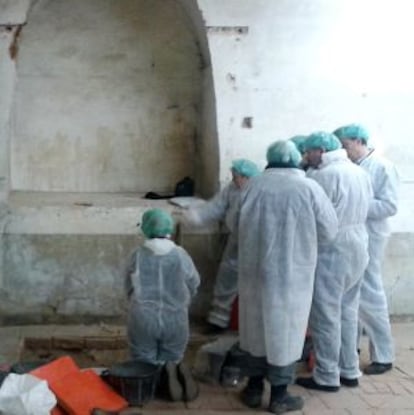Cervantes’ coffin found in Madrid crypt
Researchers looking for lost remains of ‘Don Quixote’ author unearth box marked “M. C.”

Researchers looking for the remains of Spanish Don Quixote author Miguel de Cervantes have discovered a coffin containing bone fragments and bearing the initials “M. C.” inside the religious building in Madrid where he is believed to be buried.
The team of experts has been searching for Spain’s most illustrious writer inside the convent of the Monjas Trinitarias Descalzas, on Lope de Vega street, in the capital’s Barrio de las Letras neighborhood, since April of last year.
Cervantes’ body has been missing for four centuries, lost somewhere within the walls of the convent, where a church once stood. Historical records show that the author was buried there on April 23, 1616.
Cervantes was 68 when he died, had only six teeth left, and his back was bent by degenerative joint disease
The find was made inside the crypt on Saturday, where six tombs were found last week. Most of the coffin was in bad shape as a result of the effects of damp and wood-eating insects – all except for the top portion, where rusty tacks hammered into the lid spelled out the initials M.C..
But the team led by forensics expert Francisco Etxeberria says it is too early to say if the bones found inside the coffin are really those of the creator of the timeless knight-errant Don Quixote and his faithful sidekick Sancho Panza.
There were over 10 scholars inside the crypt at the time of the find. On Saturday morning reporters were allowed into the space for the first time. The burial chamber lies 4.80 meters below the church floor.

Researchers report finding a variety of bone fragments inside the coffin, some of which clearly belong to children. Archeologists and forensics experts will now have to separate these from the adult bones, then divide the latter between female and male, and finally search for clues such as bone atrophy in the left hand and impacts from arquebus shots in the breast bone, which Cervantes suffered at the Battle of Lepanto, a major naval battle that put the Holy League against the Ottoman empire in 1571.
Several other anatomical facts could also guide the experts in their search: Cervantes was 68 when he died, had only six teeth left, and his backbone was bent over by degenerative joint disease.
Scholars are also examining the remains of the religious shroud in which the literary giant was presumably buried – some time before his death, Cervantes had joined the venerable Third Order of Saint Francis, a secular association whose members live by religious ideals. The wood from which the coffin is made could also shed light on the investigation, as its age can be determined through various procedures.
Tu suscripción se está usando en otro dispositivo
¿Quieres añadir otro usuario a tu suscripción?
Si continúas leyendo en este dispositivo, no se podrá leer en el otro.
FlechaTu suscripción se está usando en otro dispositivo y solo puedes acceder a EL PAÍS desde un dispositivo a la vez.
Si quieres compartir tu cuenta, cambia tu suscripción a la modalidad Premium, así podrás añadir otro usuario. Cada uno accederá con su propia cuenta de email, lo que os permitirá personalizar vuestra experiencia en EL PAÍS.
¿Tienes una suscripción de empresa? Accede aquí para contratar más cuentas.
En el caso de no saber quién está usando tu cuenta, te recomendamos cambiar tu contraseña aquí.
Si decides continuar compartiendo tu cuenta, este mensaje se mostrará en tu dispositivo y en el de la otra persona que está usando tu cuenta de forma indefinida, afectando a tu experiencia de lectura. Puedes consultar aquí los términos y condiciones de la suscripción digital.
Últimas noticias
There is as much life left to discover on planet Earth as that which is already known
Dozens presumed dead, around 100 injured in fire at Swiss Alps bar during New Year’s celebration
Is porn for women different from conventional porn? We spoke to those who make it
Cartagena de Indias is sinking: What can the city do to mitigate it?
Most viewed
- Sinaloa Cartel war is taking its toll on Los Chapitos
- Reinhard Genzel, Nobel laureate in physics: ‘One-minute videos will never give you the truth’
- David King, chemist: ‘There are scientists studying how to cool the planet; nobody should stop these experiments from happening’
- Oona Chaplin: ‘I told James Cameron that I was living in a treehouse and starting a permaculture project with a friend’
- The Interoceanic Train, the Mexican alternative to the Panama Canal








































